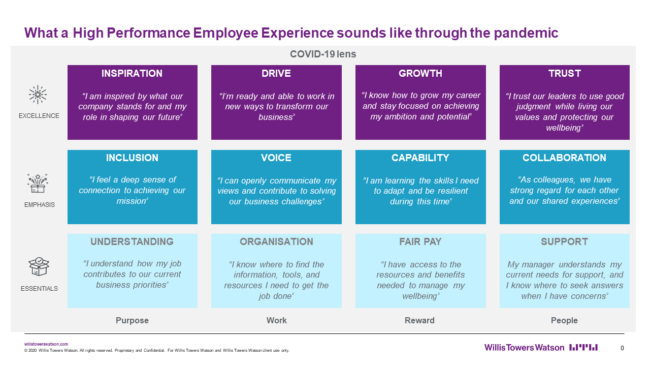Supporting the employee experience through Covid-19 and accelerating back to growth
Covid-19 has impacted the workforce in unprecedented ways resulting in massive, incredibly rapid changes across industries. No two organisations have been impacted in the same way. From mass recruitment in parts of some sectors to mass furloughing in other parts of the same sector; from mass home-working in many areas to some employees having no choice but to go to work, the employee experience has never seen more challenging circumstances.
With that challenge in mind, how do you effectively support the employee experience through this time of turbulence and uncertainty? One thing that is clear is that the actions of leaders are key. Workforce-related actions that companies take at times like these send signals to all stakeholders – employees, consumers and investors. This is a moment where leaders, through the decisions they make today and their ability to respond tomorrow, will define who they are.
Why the actions of leaders are key
So, how have leaders been doing so far? Willis Towers Watson has conducted a number of pieces of research over the last couple of months asking employers (over 1000 across the UK and Europe) and employees (through normed pulse survey data and virtual focus groups), their views on the changes that have taken place and how people are managing in the current situation. If there is such a thing as a silver lining, it has been the way many leaders seem to have risen to the challenge of protecting their employees and preserving the unique culture that they have strived hard to create. Through our research, it is clear that leaders have been quick in establishing a remote working environment (75% or respondents) whilst maintaining productivity (57% reported little or no loss in productivity due to working remotely)*.
However, whilst social communication tools are being used widely to promote collaboration (81% using a range of tools), only a third of organisations have actively listened to their employees. Of those who have, it is clear that leaders have earned employees’ trust to steer through the crisis** (95% of employee trust leaders to respond to business challenges) and for the most part, employees are finding ways of managing their challenges outside of work (59%) – a good start.
Yet we’ve also seen that individuals are struggling to cope with anxiety (91% reporting some level of anxiety) – distractions from work (60% reporting some level of distraction), their ability to manage the stress they are feeling (only 43% responding positively to stress management), financial concerns (61% report some financial concerns) and poor connections are contributing significantly to this.
How do we manage over the longer-term as we focus on restoring stability?
In collaboration with the World Economic Forum, we have found these principles critical for guiding leaders’ actions in balancing the short-term pressures against medium to longer term needs:
- As mentioned, leaders are and will continue to be key – effective leaders are transparent, empathetic and trustworthy, and their behaviours help rally employees to feel vested in a common mission and purpose and embrace new ways of working.
- Adopt an agile and continuous learning mindset to ensure responses are calibrated to the circumstances at hand.
- Engage all stakeholders in decision making. Keep a pulse – develop a true listening strategy to capture the shifting needs and priorities of all stakeholders and the evolving state of competitive and innovative practices.
- Focus on the intersection of employee and company wellbeing. These are highly connected and so require a thoughtful strategy of alignment and execution.
- Balance the medium-term and longer-term business objectives vs. the human experience. This is the critical as the business experience may include deferring hiring, lay-offs, reward changes, accelerating digital working and it’s clearly linked with the human experience of adapting to change, financial worries and supporting colleagues and family.
What else can organisations be doing to maintain the employee experience at this time?
Using our High-Performance Employee Experience framework can really help focus efforts:

For example, moving up the People column from essentials to excellence:
- Employees want Support from managers who understand their current situation and needs, and they need know where to go with their concerns and questions;
- They want increased Collaboration through shared understanding and experiences, and an ability to do this virtually, and to know they’re not alone;
- And employees want to Trust that their leaders are living the values and truly care about employee wellbeing.
Moving up the Purpose column from essentials to excellence:
- Employees want to Understand what is happening and what any of these changes mean for them through regular, easy to access communication channels that give them one place to go for everything they need to know;
- They want to feel Included in what is going on and that they have a part to play in supporting the organisation and each other;
- They want to feel Inspired by their leaders and what the organisation collectively is trying to achieve – a clear vision is key.
What we also know is that high-performance companies create a differentiated experience through the hallmarks of excellence; they inspire connection to mission and purpose; they create a sense of drive through strong customer focus and marketplace agility; they provide growth opportunities to fuel employees’ ambitions and they engender deep trust in senior leadership effectiveness.
Leaders will need to continue to be change agents for the ‘reset’ to the ‘new normal’
As we continue to restore stability and start to reset the ‘new normal’, leaders will need to continue to be change agents for this, maintaining the openness and transparency that has helped maintain employee trust through the crisis, but they will also need to focus, once again, on delivering high quality work and the customer experience. Supporting people to deliver this whilst adopting more flexible working practices will require longer-term behavioural and cultural changes in many organisations.
Furthermore, leaders are expected to lead change efforts by seeing it as an opportunity to increase skill sets; in our ‘reset,’ employees will be looking to leaders to provide them with new training and developmental opportunities to reskill after COVID. This could be working on new ways to bring goods to consumers, or even in the continuation of succession planning.
What employees want to see from leaders
Employees want leaders to reduce ambiguity in new policies and procedures by probing in areas that lack clarity. They want to see leaders learning from the past by making sure that any new practices put in place will assist and guide in future events like this.
Finally, and key to all of this, is remembering to treat employees as humans. They are your biggest asset, otherwise, why would the employee experience matter?
*Willis Towers Watson COVID-19 Employer Survey
** Willis Towers Watson Employee Opinion Norm Database
About the author

Gaby leads Willis Towers Watson’s Talent line of business in GB. As a Senior Director with Willis Towers Watson, she has over 20 years’ experience in supporting major merger integration, business transformation and employee experience projects on a pan-European and global basis. She specialises in organisation transformation and effectiveness, culture transformation, change management, leadership effectiveness and development and broader talent management issues to help organizations successfully implement and embed change and drive their desired employee experience. As part of her work, Gaby is accredited in Saville Wave assessment tools, Hogan leadership assessment tool, the Myers-Briggs Type Indicator, the Strength Deployment Inventory and the Human-Synergistics organization Culture Inventory Tool . Over the years, she has worked with many global organisations to help them drive performance through their people.











